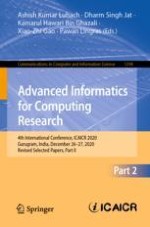2021 | Book
Advanced Informatics for Computing Research
4th International Conference, ICAICR 2020, Gurugram, India, December 26–27, 2020, Revised Selected Papers, Part II
Editors: Ashish Kumar Luhach, Prof. Dharm Singh Jat, Prof. Kamarul Hawari Bin Ghazali, Prof. Dr. Xiao-Zhi Gao, Pawan Lingras
Publisher: Springer Singapore
Book Series : Communications in Computer and Information Science
